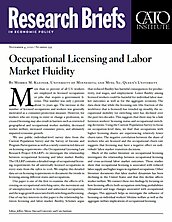More than 20 percent of all U.S. workers are employed in licensed occupations or jobs that require a government license. This number was only 5 percent about 70 years ago. The increase in the number of licensed occupations and workers was generally motivated as a consumer-protection measure. However, for workers who are trying to enter or change a profession, increased licensing may also result in barriers such as restricted geographical and occupational worker mobility, decreased worker welfare, increased consumer prices, and ultimately impaired economic growth.
We use public individual-level survey data from the Current Population Survey and the Survey of Income and Program Participation as well as a newly constructed data set on licensing requirements—the Occupational Licensing Law Research Project (OLLRP)—to investigate the relationship between occupational licensing and labor market fluidity. The OLLRP contains a detailed range of occupational licensing requirements for all universally licensed occupations in every state from the 1980s to 2016.
We employ this detailed data set on licensing requirements to document the trends in licensing among different states and occupations. Our paper is one of the first to examine the effects of licensing on occupational switching rates, the movement out of unemployment to licensed and unlicensed occupations, and the wage growth associated with switching and licensing. One of our key interests in this paper is the relationship between licensing and labor market fluidity. Scholars argue that reduced fluidity has harmful consequences for productivity, real wages, and employment. Lower fluidity among licensed workers could be harmful for individual labor market outcomes as well as for the aggregate economy. The data show that while the licensing rate (the fraction of the workforce that is licensed) has trended up steadily, the occupational mobility (or switching rate) has declined over the past two decades. This suggests that there may be a link between workers’ licensing status and occupational switching decisions. Using the Current Population Survey to focus on occupation-level data, we find that occupations with higher licensing shares are experiencing relatively lower churn rates. The negative correlation between the share of workers who are licensed and the occupational churn rate suggests that licensing may have a negative effect on individuals’ labor market transition decisions.
Much of the earlier literature on occupational licensing investigates the relationship between occupational licensing and cross-sectional labor market outcomes. These studies show that occupational licensing is associated with reduced labor supply and higher wages in regulated occupations. Other literature documents that labor market dynamism has been declining in the United States and that this decline affects worker welfare. We connect these two findings by focusing on how licensing affects both occupation switching probabilities (dynamism) and wage changes associated with occupational changes. This approach helps us investigate the influence of licensing on individual workers’ lifetime welfare as well as the aggregate welfare implications of occupational licensing.
One of our contributions is a detailed use of the OLLRP data set, which establishes new historical data patterns and trends in occupational licensing laws. Specially, we measure the degree to which occupational licensing costs have changed (increased) for workers over time in different states and occupations. Our second contribution is an examination of the relationship between licensing, occupational switching, and the wage changes associated with these transitions. We compare the switching patterns and wage changes of workers who are licensed with those of workers who are not based on a series of observable worker characteristics as well as the skill requirements of the occupations. The findings show that occupational licensure has significant negative effects on occupational mobility when switching both into and out of licensed occupations. Specifically, we find that workers who are licensed are 23.6 percent (9.7 percentage points) less likely to switch to another occupation after one year and 3 percent (0.5 percentage points) less likely to become unemployed. Workers who are licensed are 24.1 percent (9.6 percentage points) less likely than other workers who are not licensed to have just switched into their occupation. After controlling for observable differences, we find that those switching into a licensed occupation experience higher wage gains (a 5.4 percentage point higher growth rate, or an additional $1,834, for the average worker) than those switching into a nonlicensed occupation. Workers who are currently licensed experience higher wage growth after one year regardless of whether they stay in the same occupation (on average, 6.3 percentage points higher in log wage changes, or $2,208 more, than nonlicensed workers) or switch occupations (on average, 3.8 percentage points higher, or $1,251 more, than nonlicensed workers).
Furthermore, we find that licensing presents less of a barrier to entry for the unemployed than for employed workers, possibly because of differences between the two groups in the opportunity cost of time to meet government requirements. Finally, we do a back-of-the-envelope calculation and find that licensing can account for at least 7.7 percent of the total decline in occupational mobility over the past two decades. These results suggest that in addition to static general equilibrium welfare effects, licensing also has significant lifetime welfare effects for workers through impacting their dynamic occupational career choices.
NOTE:
This research brief is based on Morris M. Kleiner and Ming Xu, “Occupational Licensing and Labor Market Fluidity,” NBER Working Paper no. 27568, July 2020, https://doi.org/10.3386/w27568.
About the Authors
Morris M. Kleiner, University of Minnesota; and Ming Xu, Queen’s University

This work is licensed under a Creative Commons Attribution-NonCommercial-ShareAlike 4.0 International License.
